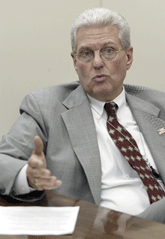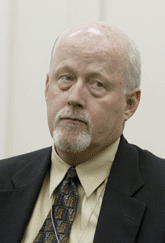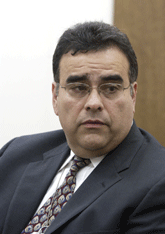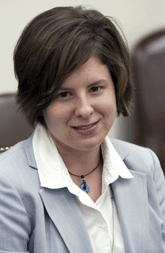The road to e-government might look like an uphill climb to government managers. But it's not like they have a choice.The 25 Quicksilver projects that have dominated the Office of Management and Budget's push toward e-government for the last couple of years are nearing completion. Now it's time for managers across government to join the march.[IMGCAP(2)] They must tie e-government plans to business cases, budget submissions and enterprise architectures and make them conform to the Federal Enterprise Architecture. They must hire project managers for all large initiatives.And lurking just a few months away is the Government Paperwork Elimination Act's October deadline. GPEA, enacted five years ago, requires agencies to offer citizens and businesses the option of submitting information or transacting business electronically.It no longer can be business as usual: E-government, either directly or indirectly, is driving the agenda.Norman Lorentz, the Office of Management and Budget's chief technology officer, agrees that the way ahead won't be a cakewalk.'It's a journey,' he said.E-government is no longer a matter of putting forms online'electronic versions of paper'as it largely was when GPEA became law in 1998.'Effective GPEA implementation requires simplified business processes, systems consolidation and secure data transactions,' Mark Forman, OMB's administrator for e-government and information technology, told agency CIOs in a recent memorandum on GPEA.In 2003, e-government is not the end but the means toward what the administration calls transformation. 'E-government is a transformation tool,' Lorentz said.Transformation entails fundamentally retooling the federal government's business processes around service to its constituents, Lorentz said.[IMGCAP(3)] Ultimately, a transformed government could look like the vision propounded in a National Commission on Public Service report, issued earlier this year, Lorentz said.The commission, chaired by former Federal Reserve chairman Paul Volcker, recommended that the federal government be reorganized into a limited number of executive superdepartments, 'combining as many operating agencies that have a rational connection with each other as possible.''It's a consolidation of technology, human capital and fixed assets around the citizen,' Lorentz said. While the end result may be realized in citizen services, the bulk of the work will take place behind the scenes.Consolidating systems is not an end in itself, he said. It is a method of contributing to an outcome. 'Ultimately, if you consolidate business processes, you'll consolidate the technology in the business processes,' Lorentz said.[IMGCAP(4)] 'From a governmentwide perspective, it's important to focus on both the policy and the process first,' said Jeannette Thornton, OMB's e-authentication portfolio manager. 'Without having both of those things in place on an enterprise level, you're not going to be implementing the technology in the most effective way possible.'Enterprise architectures are an important instrument for consolidating business processes, said Robert Haycock, OMB's chief architect and program manager for the Federal Enterprise Architecture Program Management Office.An enterprise architecture provides a comprehensive view of what an organization does, how it does it and how IT supports it. Agencies are developing their own internal enterprise architectures. In addition, OMB is building the governmentwide Federal Enterprise Architecture.'You need a common framework to give you the ability to start looking at things in a different way,' Haycock said. 'That's why the agencies have enterprise architectures as well. They've got to figure a way of rationalizing their business processes. Then you begin to rationalize processes across agencies with the FEA.'The impetus for transformation must come from both the upper and lower levels of government, OMB officials said.On the federal level, the drive for transformative e-government is coming from the top with the FEA and from the bottom with OMB's 25 Quicksilver e-government initiatives, Lorentz said.'The top-down approach shows you have commitment at the highest levels,' said Stephen Galvan, Small Business Administration CIO and until recently portfolio manager for internal effectiveness and efficiency for the Quicksilver projects. 'The bottom-up approach shows you're achieving cultural change at the agency level. Without both of those, it's going to be very difficult to move forward.'[IMGCAP(5)] Although such cultural and organizational barriers have the potential to slow the evolution of e-government, what technical roadblocks remain on the way to transformation? Few, OMB officials say.Securing electronic transactions with public-key infrastructure technology, for example, is for the most part a matter of setting policy, Thornton said.'We've seen agencies successfully implement the technology,' she said. 'I don't think that's the problem. The problem is how we're going to get the best investment as a government and how we're going to implement and utilize this technology to the fullest extent possible.'But the first step is to look at requirements and risks before deciding what security and authentication technologies to use.OMB has drafted governmentwide standards to guide agencies on the levels of identification and verification required for programs. The guidance is currently under review by agency CIOs.'Not every transaction is going to require [PKI] technology,' Thornton said. 'We have many successful examples of transactions between citizen and government that don't use anything that's very complicated.'The guidance, she added, will help agencies determine what type of technology is really needed for specific applications. 'We may find that some agencies are too strict on requirements, others not strict enough,' she said. 'I think having a governmentwide policy is really important for us to get to that point.'Jonathan Womer, OMB's government-to-citizen portfolio manager, noted that Secure Sockets Layer technology is used every day on the Internet to secure transactions.'We're going to find out where [PKI] is appropriate and where it is not,' he said. 'For some transactions it obviously is, but others are just not going to need this sort of thing.'Haycock conceded that deploying a PKI infrastructure is not technically trivial but said that PKI implementation, at bottom, is an issue of enterprise architecture.[IMGCAP(6)] 'The problem is we're not that far along on [designing] our organizational or technological architectures, so it's a tremendous job to throw in a PKI infrastructure because you have to architect after the fact,' he said.Thornton gave an example of this after-the-fact approach to PKI.'I had an agency [official] call me up and say, 'We're implementing this great technology. How do you think we should use it?' ' she said. She declined to identify the agency.Another technology posing hurdles to e-government is wireless.'Radios aren't plug-and-play today, like software,' said Tony Frater, OMB's government-to-government portfolio manager. 'You can go buy a version of a piece of software and load it on your computer. That's easy to do now. But radios are a lot more complicated than that. Two people can have two of the same kind of radio, but they may not be able to interoperate. So there's some work to be done there.'Radio-frequency technology is especially integral to public-safety initiatives such as Quicksilver's Project Safecom, which would connect wireless first-responder systems across federal, state and local agencies.Making such systems interoperable is critical.'Interoperability is a big chunk of it,' Frater said. 'We have 40 different kinds of [wireless] technologies.'But government also will have to develop wireless infrastructures to accommodate future citizen demands as well, Frater said.'Some people like to write letters, others like to make phone calls,' Frater said. 'Someday, there's probably going to be a proportion of the population that would like to get on their form-enabled Web phone and fill out a form or take a survey.'Giving citizens a choice is a large part of OMB's vision for e-government. 'I envision a government where I have a choice as a citizen,' Thornton said. 'I can choose which transactional engine I want to trust and can use that to interact with the government. ... It's more than just automating the process.'Increasingly interactive e-government also will help government officials make better choices, Womer said, citing the Environmental Protection Agency's E-Rulemaking project, a Quicksilver initiative, as helping to pave the way.'It's really one of the first steps we've taken in the e-democracy world, where people can be much more participatory in the process of making policy,' he said. 'I'm hopeful that will make the government make better choices and have a better idea of what citizens want but also that citizens will feel more connected to policies as they're made through the process.'Such electronic interaction will bring more transparency to government, Frater said.'The more access I have to information, the more ability I have to look at what my government is doing,' he said. 'I think the tools we're going to have will enable us to do that.'
'E-government is a transformation tool,' OMB's Norman Lorentz said.
Henrik G. DeGyor
Jonathan Womer, top, government-to-citizen portfolio manager, says the type of transaction determines the necessary level of authentication.
Interoperability is a key to many public-safety initiatives, says Tony Frater, the government-to-government portfolio manager, and 'there's some work to be done there.'
OMB chief architect Bob Haycock says an agency's enterprise architecture is the first step in developing processes across agencies.
Stephen Galvan, the Small Business Administration's CIO, says transformation success requires commitment from the highest and lowest levels of government.
Jeanette Thornton, OMB's e-authentication portfolio manager, says policy and process must come before technology.












